About Us
Advanced Roofing Technologies, your dependable partner for durable, efficient, and affordable flat roofing solutions. Protecting your home, one roof at a time.
Instant Quote Instant QuoteContact Info
- 950 W Venango Street
Philadelphia PA 19140 - 267-277-2124
- [email protected]
- Week Days: 09.00 to 18.00
Sunday: Closed
Flat Roof Repair
- Services
- Flat Roof Repair
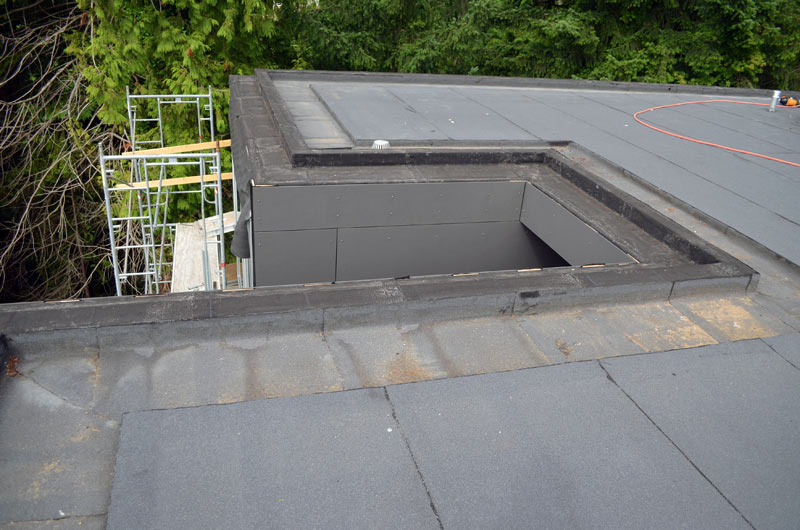
Flat and low-slope roofs are common in both residential and commercial buildings. While they offer unique design and space utilization advantages, they also require proper maintenance to ensure their longevity and effectiveness in protecting the structure beneath.
Low-Slope and Flat Roof Leaks: Stop Immediately
No more panicking over flat roof leaks! Advanced Roofing Technologies is well equipped to diagnose these problems and suggest the best course of action for your flat roof.
We don't just stop the water; we investigate the root cause, employing the latest techniques and military grade liquid membrane to ensure a comprehensive and enduring solution.
Our expert team is adept at identifying water intrusion point, inspecting for signs like water stains, mold, or damaged roof materials, and rectifying leaks quickly. We offer suggestions for a proper and timely repair process and ensure minimum disruption and maximum protection.
Professional Flat Roof Repair Process
The flat roof repair process involves several steps to ensure a durable and effective solution for addressing issues such as leaks, cracks, or damaged roofing materials. Understanding the process can help you navigate the repair journey more confidently.
» Thorough Inspection
The first step in flat roof repair is a thorough inspection. A professional roofing contractor will assess the condition of the roof, identify the root cause of the problem, and determine the extent of the damage. This assessment is essential for creating an accurate repair plan.
» Repair Preparation
Once the inspection is complete, the next step is to prepare the roof for repair. This may involve cleaning the surface, removing debris, and ensuring proper adhesion for repair materials. Proper preparation is crucial to ensure the effectiveness and longevity of the repair.
» Actual Repair
The actual repair process can vary depending on the specific issue. It may involve patching damaged areas, replacing worn-out roofing materials, or applying coatings or sealants to reinforce the roof's integrity. The repair method chosen will depend on the type of roof and the extent of the damage.
» Final Inspection
After the repair is completed, a final inspection is conducted to ensure the repair has been successful. The roof is checked for proper sealing, structural stability, and any remaining issues that need attention.
How Much Does Flat Roof Repair Cost?
Flat roof repair cost varies depending on several factors. The extent of the damage, the size of the roof, the materials used, and the complexity of the repair process all play a role in determining the overall cost.
Minor flat roof repairs such as patching a small area or fixing a minor leak can range from $200 to $500. However, more significant flat roof repairs that involve replacing a larger section of the roof or addressing extensive damage can cost anywhere from $1,000 to $3,000 or more. Keep in mind that these figures are just estimates and the actual cost can be higher or lower depending on your specific situation.
In addition to the repair itself, there may be additional costs associated with the project. For example, if the underlying insulation or decking is damaged and needs to be replaced, that will add to the overall cost. Furthermore, if your roof requires regular maintenance or if there are any underlying issues that need to be addressed simultaneously, these factors can also affect the total cost of the repair.
Causes of Low-Slope and Flat Roof Issues
Flat roofs, while beneficial in many ways, are susceptible to certain types of damage. Water leaks can infiltrate the building structure, leading to mold growth, rot, and damage to the interior finishes. This not only compromises the structural integrity of the building but also poses health risks to occupants and employees.
Regardless of the size and location of the issue, if flat and low-slope roof issues are neglected or left unaddressed, they can result in significant consequences.
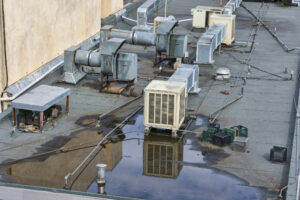
Ponding Water
Flat roofs don't drain water as effectively as sloped roofs, leading to stagnant water, or "ponding". This can gradually degrade your roofing material. Identifying ponding is easy as you'll see pools of water on your roof 48 hours or more after the last rainfall.
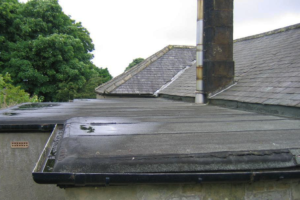
Weathering and Aging
Over time, weather conditions such as sun, rain, wind, and snow can cause the roofing materials to break down. Signs of aging and weathering include surface cracking, blistering, or a general worn-out look.
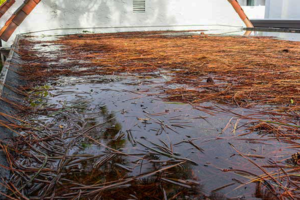
Debris Accumulation
Leaves, branches, and other debris can accumulate on flat roofs, blocking drainage and causing water to pool. Regular inspection can easily spot this problem.
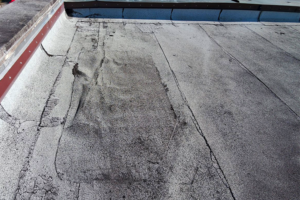
Thermal Movement
Changes in temperature can cause materials to expand and contract, potentially leading to cracks or splits. Look for signs of cracking or splitting in the roof surface.
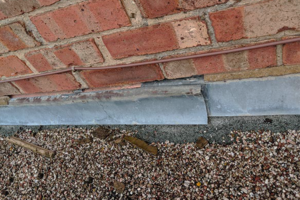
Damaged Flashing
Flashing serves as a protective barrier around roof penetrations, edges, and transitions. Damaged or loose flashing can result in water infiltration. Repairing or replacing flashing is essential to maintain a watertight seal.
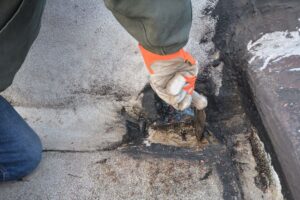
Improper Installation
If the roof isn't installed properly, it can lead to leaks and other issues. Signs might include uneven surfaces, poor seams, or visible leaks indoors.
Detect Small Flat Roof and Low-Slope Roof Issues
Small flat roof and low-slope roof issues typically refer to localized problems that can be addressed with minor repairs or maintenance. These issues may not pose an immediate threat to the overall integrity of the roof and can be easily resolved with minimal intervention. Some examples of small flat roof and low-slope roof issues include:
Small Leaks: Occasional or minor leaks that are confined to a specific area of the roof. These leaks may result from damaged flashing, a puncture in the roofing membrane, or a small crack in the roof surface.
Blistering or Bubbling: Small areas of blistering or bubbling on the roof's surface, often caused by trapped moisture or inadequate ventilation. These issues can usually be repaired by removing the affected area and applying new roofing materials or coatings.
Cracked or Damaged Flashing: Localized damage to the flashing around roof penetrations, edges, or transitions. This can lead to water infiltration and requires the replacement or repair of the damaged flashing components.
Ponding Water in Small Areas: Limited areas of standing water on the roof's surface, typically caused by inadequate slope or poor drainage. These areas may require adjustments to the roof's slope or the installation of additional drainage systems.
Detect Big Flat Roof and Low-Slope Roof Issues
Big flat roof and low-slope roof issues refer to more extensive or severe problems that require significant repairs or potentially even roof replacement. These issues can have a broader impact on the roof's overall performance and may pose a greater risk to the structural integrity of the building. Examples of big flat roof and low-slope roof issues include:
Widespread Leaks: Multiple and persistent leaks occurring throughout the roof's surface, indicating more significant damage or deterioration of the waterproofing system. These leaks may necessitate a thorough inspection to identify the extent of the damage and determine the appropriate repair strategy.
Extensive Blistering or Bubbling: Large areas of blistering or bubbling that cover a substantial portion of the roof. This may indicate underlying moisture problems or inadequate ventilation and could require the replacement of the affected roofing materials.
Structural Instability: Signs of sagging or significant structural movement, suggesting a compromised roof structure. These issues may require not only roof repairs but also the involvement of a structural engineer to assess and address the underlying structural concerns.
Widespread Ponding Water: Large areas of standing water on the roof's surface, potentially causing accelerated deterioration and compromising the roof's structural integrity. Resolving these issues may involve reconfiguring the roof's slope, installing additional drains, or exploring more extensive waterproofing solutions.

